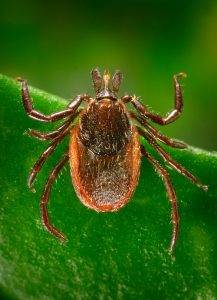Tick Season Is in Full Swing

Photo of a Western Black-Legged Tick from Wikimedia Commons | Taken by the Centers For Disease Control and Prevention
Press release from the Trinity County Department of Health and Human Services:
Trinity County Public Health would like to remind residents that we are in the midst of active tick season in Northern California. The months of May, June, and July are typically when we see the highest risk for contracting Lyme disease from a tick bite, with nymphs seeking a blood meal to fuel their growth into adult ticks.
Ticks are small arachnids most often found in naturally vegetated areas. There are many different kinds of ticks in California, but only the western black-legged tick (Ixodes pacificus) transmits Lyme disease. This reddish-brown tick is found in most California counties, but is more common in the humid Coast Range, Klamath Mountains, and the western slope of the northern Sierra Nevada.
Ticks can be found in tall grass and brush in urban, suburban and rural settings. Adult ticks climb to the tips of vegetation, often alongside trails or paths, and wait for a host to brush against them. They attach to animals and humans and feed on blood by inserting their mouth parts (not their whole bodies) into the skin.
An individual may become infected with the bacteria that causes Lyme disease when bitten by an infected western black-legged tick. As the number of tick borne diseases continues to increase, the first line of defense for all these diseases is taking precautions to avoid tick bites.
• Avoid areas where ticks live if possible.
• Wear light colors so ticks can be easily seen if they get on your clothing.
• Wear long pants and long – sleeved shirts. Tuck your pants into your boots or socks, and tuck your shirt into your pants.
• Use repellant registered for use against ticks which contains at least 20% DEET. Always read and follow the label directions when applying repellents.
• Thoroughly check yourself and your children frequently for ticks, especially at the hairline, base of the scalp, under the arms, in and around ears, inside the belly button, behind the knees, between the legs and around the waist.
• Routinely check your pets for ticks and remove them promptly. Check with your veterinarian for appropriate tick control products.
• If you have been in a known tick area, it is important to perform body checks for up to 3
days after leaving the area due to the possibility of a small nymph that has matured.The University of Wisconsin has a free mobile app, The Tick App, to assist with tick identification, which is available through your app store. Additional resources can be found on the California Department of Public Health website. Tick testing is available for a fee from the Sonoma County Department of Health Services.
Please visit the Trinity County Public Health website for more information or for links to additional resources. For questions related to Lyme disease contact Trinity County Public Health at 530-623-8209 or toll free 800-766-6147.

Join the discussion! For rules visit: https://kymkemp.com/commenting-rules
Comments system how-to: https://wpdiscuz.com/community/postid/10599/
And above all if a tick is attached to you, take it off and contain it in something. Then the next thing you need to do is go to your doctor and let him see what kind of tick it is or if you see a bulls- eye but no tick still go to the doctor where he can give you antibiotics to keep you from getting Lyme’s disease. Trust me I know first hand about these little devils.
Tick identification at the Humboldt County Public Health Lab across from the courthouse in Eureka is free. If the species is a known carrier of Lyme they can also test the tick for $45. Or $40. I can’t remember. Most species locally are not carrier for Lyme so typically you can rule it out for free there. FYI Humboldt.